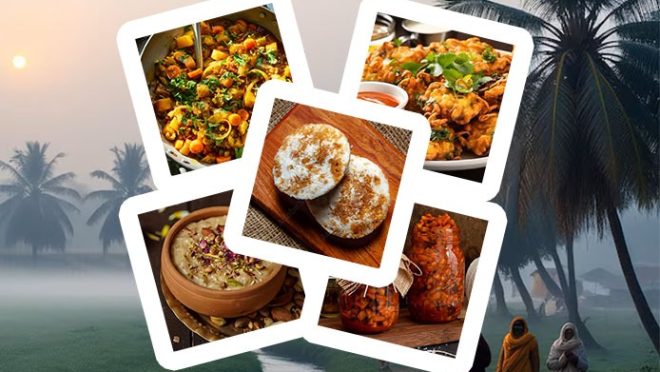Winter warmth: Cozy delights of Bangladeshi cuisine
Winter warmth: Cozy delights of Bangladeshi cuisine

For centuries, the culinary delights of Bangladesh’s winters have captivated hearts and delighted taste buds. At the heart of this winter wonderland lies the humble pithas in all shapes and forms both savoury and sweet.
Pitha is more than just food. It’s a memory, a tradition, and a symbol of warmth flashbacks from childhood.
Any pitha – be it bhapa, chitoi or puli – evokes images of cosy winter evenings spent with loved ones, the aroma of freshly steamed rice cakes filling the air.
The diversity of pitha is as vast as the country itself. From the soft and fluffy Bhapa Pitha, often filled with a sweet mixture of jaggery and coconut, to the crispy Puli Pitha, these rice cakes come in various shapes, sizes, and flavours.
Another delightful treat is Pathishapta, a spongy crepe filled with khirsha made with milk, sugar and/or coconut. And let’s not forget the Chitoi Pitha, often underestimated for its bland taste but it is like a blank canvas which gives scope of a lot of diversity. Chitoi pitha can be paired with both savoury and sweet sides like bhortas—shutki, shorisha, and dhonepata— pastes of dried fish, mustard, or coriander, or the sweet touch of jaggery and coconut.
Khejurer Rosh, a sweet, nutrient-rich sap extracted from date palm trees, is another wintertime delight. This seasonal elixir is refreshing and boasts numerous health benefits. However, to avoid getting infected with Nipa Virus one must not onsume it straight from the tree and boil it first.
Collected overnight and boiled to reduce its volume, Khejurer rosh can be consumed alone or used as a sweetener in various dishes. It can even be further processed into jaggery, available in two forms: the liquid Jhola Gur with a thick consistency and the solid Patali Gur with a brick-like structure.
While sweet treats dominate the winter scene, savoury dishes like Haleem, a hearty stew of meat, lentils, and wheat, and pakoras (deep-fried fritters) offer a savoury counterpoint. Various fish curries and vegetable curries featuring winter vegetables like cauliflower, broccoli, and carrots add to the culinary diversity. Also, for those who love duck curries winter is the time for these delicacies.
Moreover, the evergreen Grandma Pickle, or in Bangla, as they say, ‘Nani-Dadi der Achar’ is basically another tradition where various fruits like plums are dried on the terraces for pickling, adding a sour touch to the winter.
Recently, these winter delicacies were celebrated at the “Taste of Bangladesh” event. Held in the country’s capital at Banani’s Kamal Atartuk Field from 13 to 16 December, this event showcased a wide range of culinary delights, from traditional pitha to extravagant offerings from five-star hotels.
While the event aimed to highlight the rich culinary heritage of Bangladesh, some attendees felt that the execution could have been more refined. The crowded layout and lengthy security queues detracted from the overall experience.
Additionally, the high-end restaurants, while offering premium prices, lacked the ambience that would typically justify such costs.
Despite these minor hiccups, the “Taste of Bangladesh” event was a significant step in promoting the country’s culinary heritage. It brought together a diverse range of flavours and traditions, offering a truly unforgettable experience.
As winter continues, let us embrace the warmth and joy of Bangladeshi cuisine, from the humble pitha to the extravagant feasts which bring colour amidst the foggy and chilly days.


